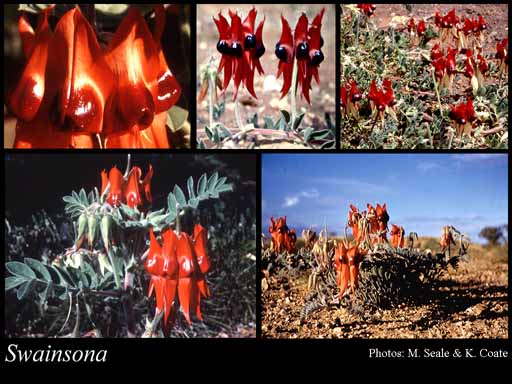- Reference
- Parad.Lond. 1(1) (1806)
- Name Status
- Current

Scientific Description
Family Papilionaceae. Galegeae.
Habit and leaf form. Herbs; not resinous. Annual, or biennial, or perennial; plants with neither basal nor terminal concentrations of leaves. Mesophytic, or xerophytic. Leaves medium-sized; alternate; distichous; ‘herbaceous’, or leathery; not imbricate; petiolate; non-sheathing; not gland-dotted; compound; epulvinate; unifoliolate (S. unifoliata), or ternate, or pinnate; imparipinnate. Leaflets 1, or 3, or 5–41. Lateral leaflets opposite. Leaflets not stipellate; pulvinate, or epulvinate; flat; without lateral lobes. Leaf blades dorsiventral. Leaves with stipules. Stipules intrapetiolar; adnate to the petiole, or free of the petiole; free of one another; subulate, ‘triangular’ or frequently herbaceous; persistent. Leaf blade margins entire. Leaves without a persistent basal meristem. Stem anatomy. Nodes tri-lacunar, or penta-lacunar. Secondary thickening absent, or developing from a conventional cambial ring.
Reproductive type, pollination. Fertile flowers hermaphrodite. Unisexual flowers absent. Plants hermaphrodite. Entomophilous, or ornithophilous.
Inflorescence and flower features. Flowers aggregated in ‘inflorescences’; in racemes. Inflorescences simple. The terminal inflorescence unit racemose. Inflorescences axillary; pedunculate, axillary racemes. Flowers pedicellate; bracteate (membranous, often narrow or small); bracteolate (small), or ebracteolate. Bracteoles not adnate to the receptacle (beneath the calyx, sometimes appressed to it). Flowers small to medium-sized (4 mm to less than 2 cm long); very irregular; zygomorphic; not resupinate. The floral asymmetry involving the perianth and involving the androecium. Flowers papilionaceous (imbricate-descending, with the posterior petal outside and forming the ‘standard’); basically 5 merous. Floral receptacle developing an androphore, or developing a gynophore. Free hypanthium present, or absent. Perianth with distinct calyx and corolla; 10; 2 -whorled; isomerous. Calyx present; 5; 1 -whorled; gamosepalous; equally five lobed; imbricate, or valvate; more or less regular; non-fleshy; persistent; non-accrescent; with the median member anterior. Corolla present; 5; 1 -whorled; appendiculate, or not appendiculate. Standard appendaged to not appendaged (sometimes with callosities at junction of claw and limb). Corolla partially gamopetalous. 2 of the petals joined (the two ventral petals connivent, their claws joined, forming the ‘keel’). The joined petals of the papilionate corolla anterior. The wings of the corolla free from the keel; not laterally spurred. Standard ‘normally’ developed; entire to emarginate (orbicular or reniform, spreading or reflexed); not sericeous (glabrous). Keel about equalling the wings to conspicuously exceeding the wings (incurved); long-acuminate and beaked, or not long-acuminate/beaked (blunt or produced into a twisted beak); neither coiled nor spiralled; not bent and beaked. Corolla imbricate (descending); white to yellow (rarely), or red, or pink, or purple, or violet, or blue; deciduous. Petals clawed. Androecial members definite in number. Androecium 10. Androecial sequence determinable, or not determinable. Androecial members free of the perianth; all equal to markedly unequal; coherent (with filaments basally connate into an adaxially split sheath); 2 - adelphous (with the tenth, posterior stamen free of the rest). The staminal tube free from the keel petals. Androecial members 1 -whorled. Stamens 10; all more or less similar in shape; diplostemonous; both opposite and alternating with the corolla members. Anthers separate from one another, or connivent; all alike; dorsifixed; versatile; dehiscing via pores, or dehiscing via longitudinal slits; latrorse, or introrse; tetrasporangiate. Pollen shed as single grains. Gynoecium 1 carpelled. The pistil 1 celled, or 2 celled (by deep intrusion of the placenta). Carpels reduced in number relative to the perianth. Gynoecium monomerous; of one carpel; superior. Carpel stylate; apically stigmatic. Style (in-) curved, or hooked, or sigmoid. Style flattened, or terete. Style bearded down one side (adaxially towards the tip). Stigmatic tissue terminal. Carpel 7–50 ovuled (‘many’). Placentation marginal (along the ventral suture, the placenta sometimes intruding deeply). Gynoecium median (the placenta posterior, on the ventral suture). Ovary sessile to stipitate. Stigmas punctiform. Ovules pendulous to ascending; biseriate; arillate, or non-arillate; anatropous, or campylotropous to amphitropous, or hemianatropous.
Fruit and seed features. Fruit (6–)10–65 mm long; stipitate; non-fleshy; hairy, or not hairy; not spinose. The fruiting carpel dehiscent; a legume (the seed-bearing suture sometimes more or less intruding). Pods globose to much elongated; not triangular; straight to curved (narrow-elliptic, acute); becoming inflated (and thin), or not becoming inflated (and hardened or leathery); terete; not constricted between the seeds; not transversely septate (but often longitudinally divided); wingless. Valves of the dehisced pod not twisted. Fruit 1 celled, or 2 celled. Dispersal unit the seed. Fruit 7–50 seeded (? — ‘many seeded’). Seeds reniform; endospermic, or non-endospermic; not mucous; non-arillate. Cotyledons 2; accumbent. Embryo curved to bent (the radicle inflexed). Testa non-operculate. Micropyle zigzag, or not zigzag. Seedling. Germination phanerocotylar.
Physiology, biochemistry. Nitrogen-fixing root nodules present. Aluminium accumulation not found. Photosynthetic pathway: C3.
Geography, cytology, number of species. Native of Australia. Endemic to Australia. 2n=32. A genus of about 70 species; 47 species in Western Australia.